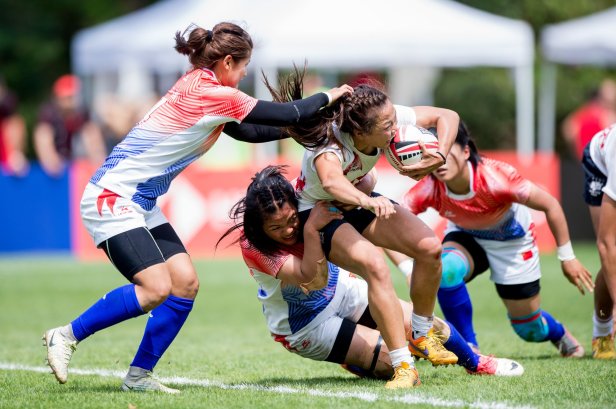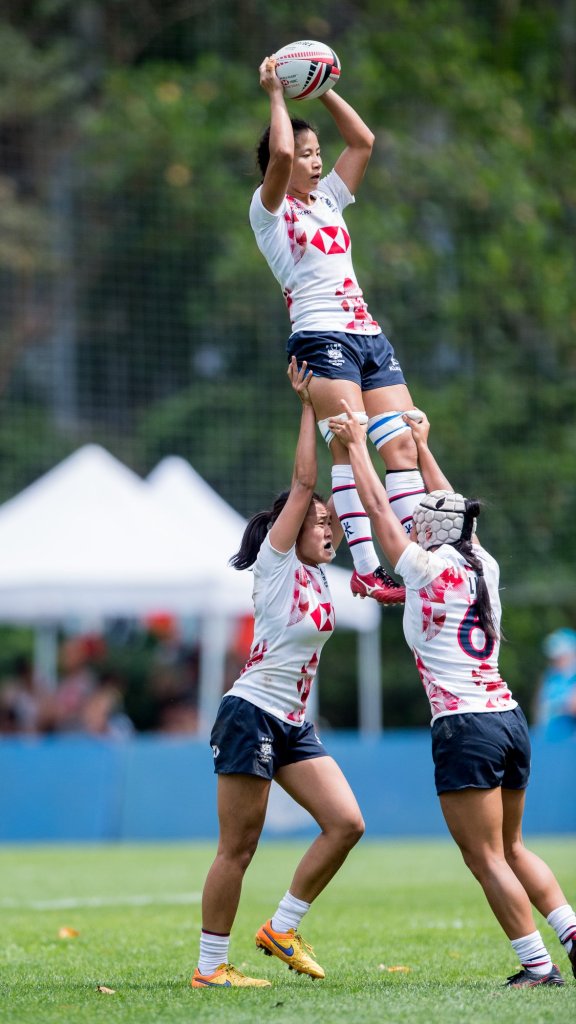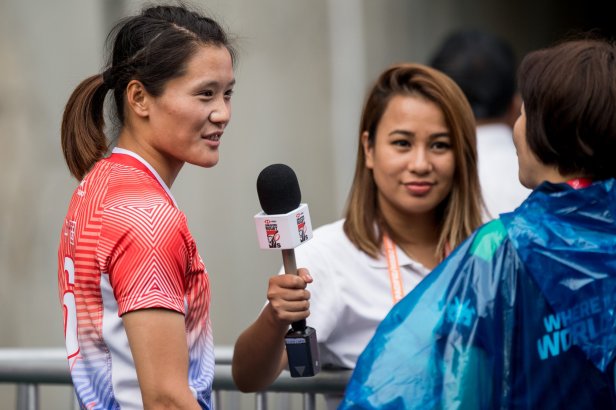“Even though the women’s game has seen an increase in coverage we all need to keep promoting it, and telling the world that rugby, and women’s rugby is fantastic!”
– Tamara Taylor
Captain of England Women Rugby Team
Nowadays, mass media plays a significant role to display the inequality of male and female players on rugby field. Rugby has traditionally been regarded as a male region as it is a contact sport, which consists of masculine characteristics such as danger, risk, aggressive, strength, and violence. While for women, people tend to believe that female rugby players are competitive but not aggressive (Szto, 2018). The differences of two genders are obviously social constructed by the mainstream media, and it constructs and utilizes gender stereotypes (Koivula, 2001). Meanwhile, the lack of coverage or acknowledgment of women’s rugby and athletes leads the sport consumers to believe that women’s rugby and athletes are not that important and not worthy of being covered (Trolan, 2013, p. 216).
Why media has biased coverage?
As the genders are social constructed, people tend to consider rugby as a male sport instead of a female sport. The media assumes its consumers are men and aligns its major coverage to the male-played games to suit its potential customers. In order to fulfill the potential male customers, the media has a biased coverage on the rugby games – focus more on the male rugby games. The media assumes that most of the consumers are men, which can help maximize the media value of rugby because “the latent media value of a sport is largely determined by the size and nature of its audience.” From the research result, it shows that rugby’s media value has traditionally benefitted from its ability to attract wealthy men aged 35 and over, who are hard to reach through TV advertising or sponsorship (HSBC, 2016, p. 20). We can see that broadcasting male-orientated rugby games helps mainstream media to benefit from its male audiences.
How important of media coverage?
Television broadcast is a central platform to engage with fans and provides a critical incentive to attract potential sponsors to the rugby players, which means that it influences the financial support of male rugby players and female rugby players (Fujak & Frawley, 2014, p. 208). As I mentioned above, unequal broadcasting can strongly influence the potential sponsors’ decisions towards the female rugby players, not the male rugby players. Potential sponsors get to know about the rugby players by watching television broadcast or other social media platforms, the more they know about that rugby player, the more understanding they have towards that rugby player; the more understanding they have towards that rugby player, the more sponsorship they are willing to offer to that rugby player. Moreover, sports content will mostly be hosted on and consumed through social platforms, whose owners will represent important opportunities for partnership, revenues and brand development (HSBC, 2016, p.9). Not only the sponsorship but the partnership, revenues and brand development for a woman rugby player are directly impacted by the unequal media coverage. As the woman rugby players do not receive enough media coverage, it leads that they are under-represented and do not have enough financial support.
Data of media coverage:
- All women’s sport sits at around 7% with broadcasters
- Over 10% of televised sports coverage
- 2% of national newspaper sports coverage
- 5% of radio sports coverage
- 4% of online sports coverage
Data of commercial investment:
- 0.4% of women’s sport
- 85.5% of men’s sport
Data of female journalists:
- 54% of journalism students are women
- 11% of sports journalism students are women.
From the data above, it clearly states that media coverage on female athletes is obviously unequal compared with male athletes. For commercial investment, there is a huge difference between women’s sport and men’s sport. Somehow, it shows that the disadvantages of unequal media coverage, leads that women’s sports do not get enough commercial investment. For the data of female journalists, it reveals that only 11% of sports journalism students are women, which means that 89% of sports journalism students are men. Since the majority of journalists and commentators are male and specifically former players or fans of the male games, they are less likely to “push the boundaries and report on women’s rugby outside of the big games or tournaments” (Shorthand – Clarissa Murphy, 2016)

Suggestion
- Increase media coverage
All media (broadcasters, digital and print press) should consistent increase their outputs of women’s rugby, not just when major women’s sports events take place. The value of female fans is increasing, which means that women are growing up more interested in rugby than previously. Meanwhile, they are the major influencers on purchasing decisions. I believe that if the media get to understand how the circumstance of female rugby audiences is, women’s sport is much more attractive to the media; the media is willing to make an effort to cover women’s rugby.
- Increase commercial investment
As the female rugby fans are major influencers on purchasing decisions, “this makes women an under-exploited audience for brands that are looking to invest in sport” (Women In Sport, 2015, p. 11). As more money is invested into the men’s rugby game, means that there is more opportunity for promotion of the game and development. However, it also means that less opportunity for promotion and development towards women’s rugby game. It leads to less demand of the media content and less financial investment. Thus, a better understanding of the women’s rugby commercial investment is needed, in order to achieve a higher level of investment.
Media coverage is “slowly but surely increasing” for women, stated by Tamara Taylor (Shorthand – Clarissa Murphy, 2016). For exmaple, the first sport sponsorship agency Female Sports Group focused purely on women’s rugby, to capitalize on the commercial opportunities that women’s rugby presents. However, HSBC reveals that women’s rugby is the fastest growing sport in the world at the moment; by 2026 40% of rugby players worldwide will be female (2016, p. 9), showing that media coverage on female rugby have to be consistently increased in order to fulfill covering most of the female rugby players, or even all of the female rugby players. Meanwhile, women in rugby should put in more effort to get recognized because of the lack of adequate representation of women’s rugby in society.

Own experience
I used to play for Hong Kong Women U19 Rugby National Team and I realized that the media coverage is unequal between female and male. Three years ago, the women U19 team and the male U19 team were having games in the same location, but different pitchs at the same time. Most of the male audiences went to the male side, and not many female audiences went to the female side. After the games, a male sport journalist came to the male side, and a female sport jornalist came to the female side. After a while, the newspaper was published, and most of the content was about the opinion and process on the male side while only the score result was reported on the female side. Instead, the journalists chose to focus more on the male side.
Moreover, during 2018 Hong Kong Women’s Rugby Sevens, women’s rugby caught more spotlight from the journalists. Because it was an international event, more journalists came to the female teams and interviewed the female rugby players, which helped the global know more about the female rugby. It was a three days event, which located in Hong Kong stadium. All the male national teams were required to have their matches in the Hong Kong Stadium incluing the qualifiers, semi-final, and final. Yet, women national teams were required to have their qualifiers in another smaller sport field, and have their semi-final and final in the Hong Kong Stadium. From this case, I thought that there was an unequal setting among the male teams and female teams.
These two examples show that there is a difference between local games and international games. I understand that more people tend to focus more on the international games instead of the local games. However, there is too much inequality for female local games, compared with the female international games. The media coverage on female’s rugby has to be consistently done. Moreover, since the World Rugby thought that there would not have many audiences for women rugby qualifiers, then they arranged the qualifiers in another saller sport field; meanwhile, the male teams were able to play their qualifiers in the Hong Kong Stadium. Somehow, it also shows the unequal site arrangement between male side and female side.

Conclusion
Although there is a notable recognition for women in rugby field in these recent years, there is still a large amount uncovered. Female rugby players still receive unpleasantly different treatment by the sport media commercial complex compared to male rugby players. Mass media has to recognize the female rugby market and distinguish the whole situation of women’s rugby. They should keep reporting the news about women’s rugby consistently. Once they increase the coverage on women’s rugby, I believe that there would be more commercial investment to be offered to women’s rugby, and increase the audiences’ awareness of female rugby Besides, female rugby players should try their best to get recognized as women’s rugby “only begins to command extensive media coverage when it establishes a compelling narrative and its stars become personalities in their own right” (SportsPro Media, 2017).
Canada International Sevens Gp. [Photograph]. Retrieved from http://www.canadasevens.com/womens/gallery/
Fujak, H., & Frawley, S. (2014). Broadcast Inequality in Australian Football. Communication & Sport, 4(2), 187-211. doi:10.1177/2167479514552672
Heywood, L., & Dworkin, S. L. (2003). Sport and the Stealth Feminism of the Third Wave. Built to win: The female athlete as cultural icon (pp. 56-85). Minneapolis: University of Minnesota Press.
HSBC. (2016). The Future of Rugby: An HSBC Report.
Jackson, S. (2014). Globalization, corporate nationalism and masculinity in Canada: sport, Molson beer advertising and consumer citizenship. Sport in Society: Cultures, Commerce, Media, Politics, 17(7), 901-916. doi:10.1080/17430437.2013.806039
Man, P. (2018, April 4). [Photogragh]. Retrieved from https://www.facebook.com/Takumiphotography/photos
Owton, H. (n.d.). Blindside of Rugby Six Nations: Where are the women? | OU Sport & Fitness Team Blog. Retrieved from http://www.open.ac.uk/blogs/OU-Sport/?p=978
Shorthand – Clarissa Murphy. (2016, April 22). Women’s rugby: coverage has a long way to go. Retrieved April 8, 2018, from https://social.shorthand.com/cjournalism3/uyMPfs6BEc/womens-rugby-coverage-has-a-long-way-to-go
SportsPro Media. (2017, September 18). The tipping point: The rising media power of women’s sports | GlobalSportsJobs. Retrieved April 8, 2018, from https://www.globalsportsjobs.com/article/the-tipping-point-the-rising-media-power-of-women-s-sports/
Szto, C. (2018, March 5). Intersectional Justice: Gender [PDF].
Taylor, S. (2017, May 25). Tackling gender inequality in sports media. Retrieved from http://www.upstart.net.au/tackling-gender-inequality-in-sports-media/
Trolan, E. J. (2013). The Impact of the Media on Gender Inequality within Sport. Procedia – Social and Behavioral Sciences, 91, 215-227. doi:10.1016/j.sbspro.2013.08.420
Women In Sport. (2015). Final Report of the Government’s Women and Sport Advisory Board. Retrieved from Department for Culture Media & Sport website: https://assets.publishing.service.gov.uk/government/uploads/system/uploads/attachment_data/file/416060/FINAL.pdf

